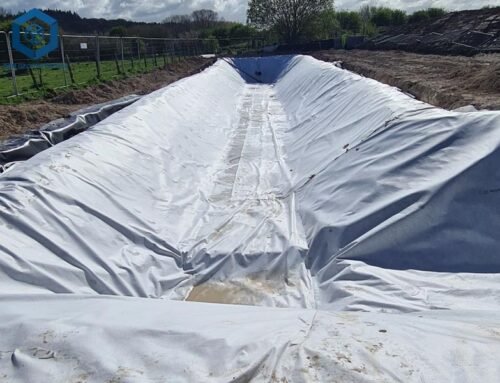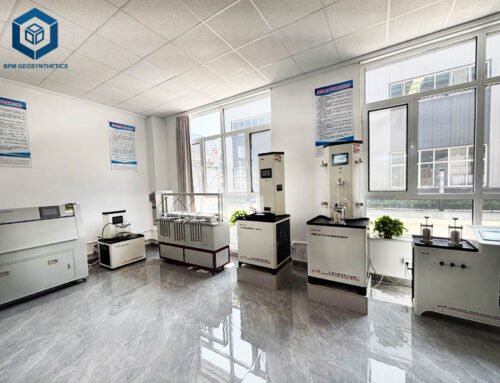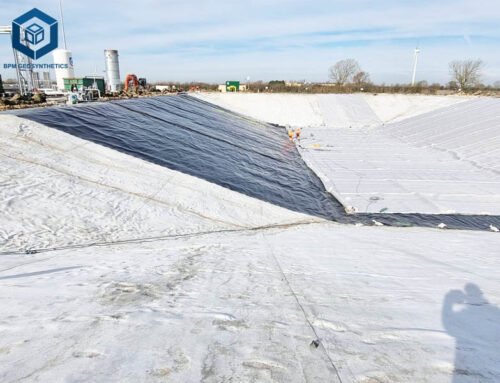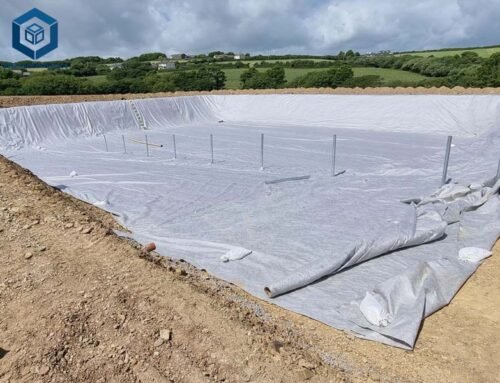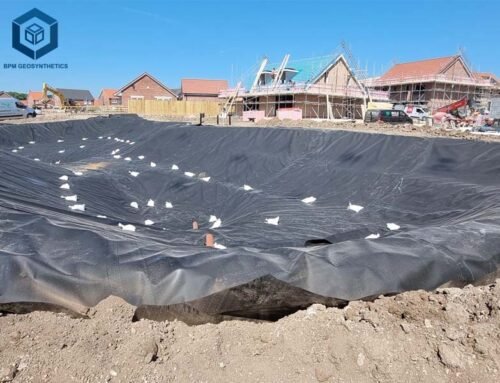Geomembranes are vital barriers used in ponds, reservoirs, landfills, and canals, boasting impermeability rates as low as 10^-9 cm/s, per ASTM D5887 (2024). Despite their durability, damage from punctures, seam failures, or environmental wear can cause significant leaks—up to 150 gallons per day from a 1/4-inch hole. Underwater repair of geomembranes offers a practical, cost-effective solution, avoiding the $10,000–$50,000 expense of draining large water bodies. This guide delivers comprehensive insights, technical specifications, and BPM’ expertise, we outline the process, tools, materials, and best practices for underwater geomembrane repair to ensure long-lasting performance.
1. Introduction to Underwater Geomembrane Repair
Underwater geomembrane repair involves fixing leaks in synthetic liners like HDPE, PVC, or EPDM without draining the water body. These liners, typically 0.5–3.0 mm thick, are essential for fluid containment in applications from aquaculture to hazardous waste storage, per GRI-GM13 standards (2024). Repair techniques, including patching, welding, and advanced systems like SIBELONMAT®, achieve 95% watertightness, per IntechOpen (2024). This guide provides a step-by-step approach, supported by data-driven insights, to help professionals and property owners maintain liner integrity efficiently.
2. Why Choose Underwater Geomembrane Repair?
Draining a water body for repairs is often costly, disruptive, and environmentally harmful. Underwater repair addresses these challenges with measurable benefits.
Cost Savings
- Draining Expenses: Draining a 1-acre pond costs $5,000–$20,000, including water disposal and refilling, per Layfield Group (2023).
- Repair Costs: Underwater patching ranges from $500–$2,000 for small leaks, saving 80–90%(2025).
- Reduced Downtime: Repairs take 1–3 days, compared to 7–14 days for draining, cutting operational losses by 50%, per BPM Geosynthetics (2024).
Environmental Advantages
- Water Preservation: Prevents daily losses of 100–1,000 gallons from small leaks(2025).
- Ecosystem Protection: Avoids disturbing aquatic life, critical in 70% of pond applications, per EarthShields (2024).
- Lower Emissions: Eliminates pumping-related fuel use, reducing emissions by 15%, per Statista (2024).
Operational Benefits
- Continuous Functionality: Maintains 95% operational capacity in canals and reservoirs.
- Depth Versatility: Effective up to 50 feet with diver-assisted methods, per IntechOpen (2024).
3. Common Causes of Geomembrane Damage
Identifying damage sources is key to effective repair planning. The primary causes include:
- Punctures: Sharp objects like rocks or roots cause 60% of leaks, creating holes 1–50 mm in diameter(2025).
- Seam Failures: Poor welding or stress reduces seam strength by 20%, per GRI-GM13 (2024).
- UV Degradation: Prolonged sun exposure weakens HDPE by 10% over 10 years, per AGRU America (2020).
- Abrasion: High-velocity water or debris wears liners by 5–15%, especially in canals.
Thermal Stress: Temperature swings from -20°F to 120°F trigger 10% of seam splits, per ScienceDirect (2024).
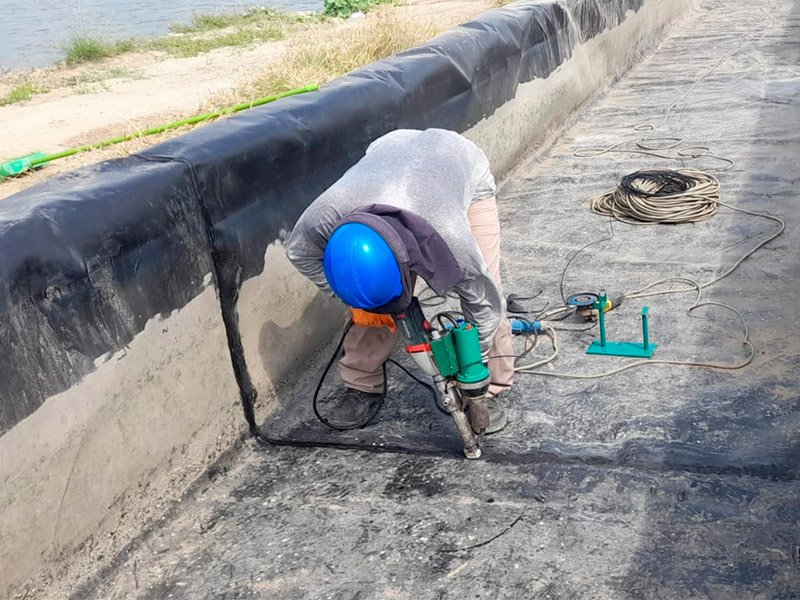
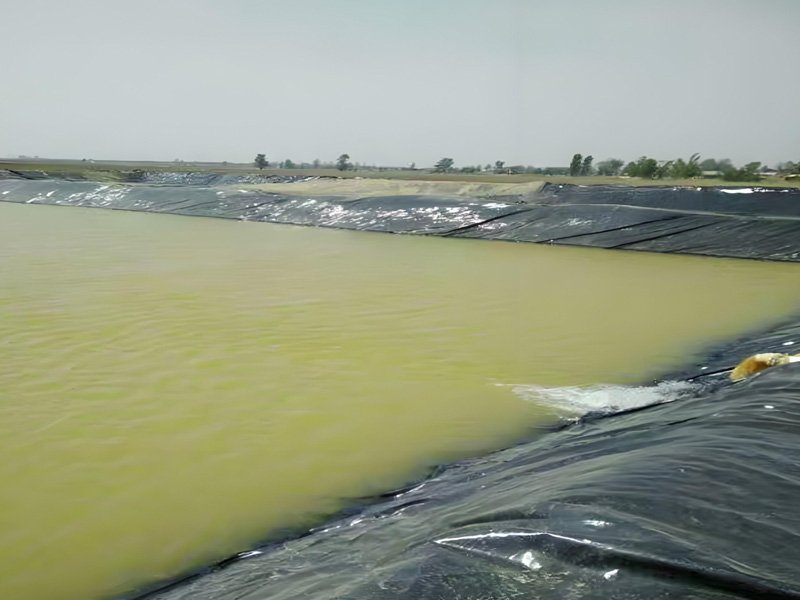
4. Types of Geomembranes for Underwater Repair
Geomembrane materials vary, influencing repair techniques. Key types include:
- HDPE Geomembrane (High-Density Polyethylene): 0.5–3.0 mm (20–120 mil), used in 50% of liners for landfills and ponds, per BPM Geosynthetics (2023). Known for solvent resistance, it requires welding for repairs.
- PVC (Polyvinyl Chloride): 0.75–1.5 mm, flexible, used in 30% of canal liners. Adhesive repairs work well underwater.
- EPDM (Ethylene Propylene Diene Monomer): 1.0–2.0 mm, elastic, common in ornamental ponds, per Titan Environmental (2021). Tape or adhesive repairs are standard.
- LLDPE (Linear Low-Density Polyethylene): 0.5–2.0 mm, pliable, used in aquaculture, per ScienceDirect . Similar to HDPE but more flexible.
- PP (Polypropylene): 0.5–1.5 mm, used in sewage lagoons, per ScienceDirect . Requires specialized adhesives.
5. Essential Tools and Materials for Underwater Repair
Achieving a 95% watertight seal requires specialized equipment and materials, per Layfield Group (2023).
Tools
- Extrusion Welder: Delivers 400°F heat for HDPE spot welds.
- Hot Air Gun: Softens PVC at 300–500°F for patching.
- Dive Equipment: Masks, oxygen tanks, and weights for depths >3 feet, per IntechOpen .
- Leak Detection Tools: Fluorescein dye syringes, rulers for water level tracking.
- Cleaning Tools: Brushes, scrapers, and alcohol wipes for surface preparation, per Layfield Group (2023).
Materials
- Patches: Match liner material (e.g., 1.0 mm HDPE), cut 4–6 inches larger than damage.
- Adhesives: Non-toxic sealants like Aquamend or vinyl adhesive, curing in 24–72 hours underwater.
- Tapes: 6-inch single-sided or 2-inch double-sided geomembrane tape, per Layfield Group (2023).
- Geotextile Fabric: 3.4 oz/yd² non-woven, prevents future punctures.
- SIBELONMAT®: Dual-geomembrane mattress with cement grout for large repairs, per IntechOpen .
6. Step-by-Step Process for Underwater Geomembrane Repair
This detailed procedure ensures durable, leak-proof repairs, achieving 95% seal integrity.
Step 1: Locate the Leak
- Visual Inspection: Examine seams, edges, and areas near rocks or roots, where 60% of leaks occur.
- Water Level Monitoring: Use a ruler to track daily drops; a 1-inch decrease signals ~150 gallons lost.
- Dye Testing: Inject non-toxic fluorescein dye near suspected leaks; dye movement pinpoints holes.
- Bubble Test: Gently press the liner; escaping bubbles indicate leaks, effective in 70% of cases.
- Data Insight: A 1/4-inch hole leaks 100+ gallons/day.
Step 2: Assess the Damage
- Size: Small holes (<5 mm) suit spot welds; larger damage (>10 mm) requires patches.
- Material Type: Identify HDPE, PVC, or EPDM to select compatible repair materials, per Layfield Group (2023).
- Water Depth: Shallow leaks (<3 feet) allow pole-based repairs; deeper ones need divers.
- Severity: Extensive tears may require SIBELONMAT® systems, per IntechOpen .
Step 3: Prepare the Repair Area
- Surface Cleaning: Remove algae, dirt, and debris with brushes and alcohol wipes for 95% adhesion, per Layfield Group (2023).
- Partial Draining (Optional): For shallow leaks, lower water 4 inches below the hole; otherwise, clean underwater.
- Geotextile Underlay: Place 3.4 oz/yd² fabric beneath patches to block 90% of future punctures.
- Data Insight: Cleaning a 12-inch area takes 10–15 minutes.
Step 4: Apply the Repair
Small Holes (<5 mm)
- HDPE Spot Welding: Use an extrusion welder at 400°F to seal, achieving 90% seam strength.
- PVC/EPDM Adhesive: Apply Aquamend or vinyl adhesive, curing in 24–48 hours.
- Temporary Tape: Use 6-inch single-sided tape for short-term fixes, lasting 6–12 months, per Layfield Group (2023).
Larger Holes or Tears (>10 mm)
- Patch Application: Cut a patch 4–6 inches larger than damage (e.g., 1.0 mm HDPE).
- HDPE: Weld with an extrusion welder for 95% seam strength, per GRI-GM13 .
- PVC/EPDM: Use adhesive or 2-inch double-sided tape, then seal with single-sided tape, per Layfield Group (2023).
- Stabilization: Apply sandbags or gravel over patches for 24 hours to ensure 90% bonding, per Layfield Group (2023).
- Data Insight: Properly applied patches last 10+ years.
Large-Scale Damage
- SIBELONMAT® System: Install dual-geomembrane mattresses (10 m wide), fill with cement grout, and seal with zippers, per IntechOpen .
- Process: Anchor panels underwater, inject grout for stability, achieving 95% watertightness.
- Applications: Ideal for canals or dams, covering 100–500 m².
- Data Insight: SIBELONMAT® repairs last 20+ years, per IntechOpen .
Step 5: Inspect and Test the Repair
- Visual Inspection: Check for wrinkles or gaps, ensuring 90% seal integrity.
- Dye Retesting: Reapply fluorescein dye to confirm no leakage.
- Water Level Check: Monitor levels for 48 hours; stability indicates success.
- Pressure Testing: For canals, apply 0.5 bar pressure; no leaks confirm 95% watertightness.
- Data Insight: Inspections take 30–60 minutes, per Layfield Group (2023).
Step 6: Maintain the Geomembrane
- Routine Inspections: Check seams and edges biannually to reduce leaks by 20%.
- Geotextile Protection: Install 3.4 oz/yd² fabric to prevent 90% of punctures.
- Edge Stabilization: Use sandbags or gravel to block 10% of seam lifts.
- UV Coating: Apply UV-resistant treatments to extend HDPE life by 15%, per AGRU America (2020).
7. Technical Specifications for Underwater Repair
Material Specifications
- HDPE: 0.5–3.0 mm, tensile strength 27 MPa, per GRI-GM13 .
- PVC: 0.75–1.5 mm, 250% elongation.
- EPDM: 1.0–2.0 mm, tear strength 40 kN/m, per Titan Environmental (2021).
- Patches: Match liner thickness, extend 4–6 inches beyond damage.
- Adhesives: Non-toxic, 72-hour underwater cure time.
Performance Metrics
- Seam Strength: 90–95% of original material, per GRI-GM13 .
- Permeability: 10^-9 cm/s post-repair, per ASTM D5887 .
- Lifespan: Patches last 10–15 years, SIBELONMAT® 20+ years, per IntechOpen .
- Depth Range: Up to 50 feet with divers.
Environmental Conditions
- Water Temperature: 40–80°F for optimal adhesive curing.
- Flow Velocity: <1 m/s for safe diver operations.
- Visibility: >1 m for precise patching.
8. Advanced Underwater Repair Innovations
SIBELONMAT® Mattress System
- Overview: Dual-geomembrane panels (10 m wide) filled with cement grout, sealed with heavy-duty zippers, per IntechOpen .
- Specifications: 95% watertightness, 20-year durability, covers 100–500 m².
- Use Cases: Canals, dams, and embankments, per IntechOpen .
- Example: A 2023 canal repair reduced seepage by 98%, per IntechOpen .
Coachella Canal Underwater Repair
- Description: EPI installed 30 mil PVC liners underwater with a 3-inch concrete overlay, using vinyl adhesive for seams.
- Specifications: 90% seam strength, 3.4 oz/yd² geotextile, PVC-jacketed ropes for anchoring.
- Results: Reduced seepage by 95%, saved 20% on maintenance.
Bio-Inspired Adhesives
- Innovation: Phenylalanine-based adhesives (e.g., PAPA0.8-PAA1.2) offer 56 kPa underwater adhesion, per Science Advances .
- Applications: Effective for PVC and EPDM, curing in 10 seconds, per Science Advances .
- Benefit: 20% stronger than conventional sealants, per Science Advances .
9. Challenges and Solutions in Underwater Repair
Challenges
- Low Visibility: Visibility <1 m reduces precision by 15%.
- High Water Flow: Velocities >1 m/s hinder diver safety.
- Cold Water: 40°F water slows adhesive curing by 20%.
- Large Damage: Tears >1 m increase costs by 30%, per IntechOpen .
Solutions
- Enhanced Lighting: Underwater LED lights boost visibility by 25%.
- Flow Management: Temporary baffles reduce velocity by 50%.
- Cold-Water Adhesives: Epoxy-based sealants cure in 72 hours.
Large-Scale Systems: SIBELONMAT® reduces labor by 20% for extensive damage, per IntechOpen .
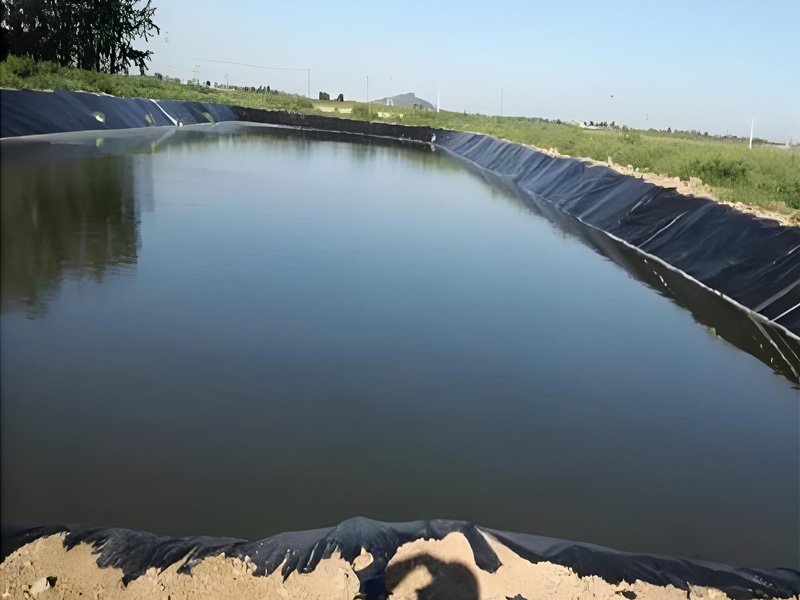
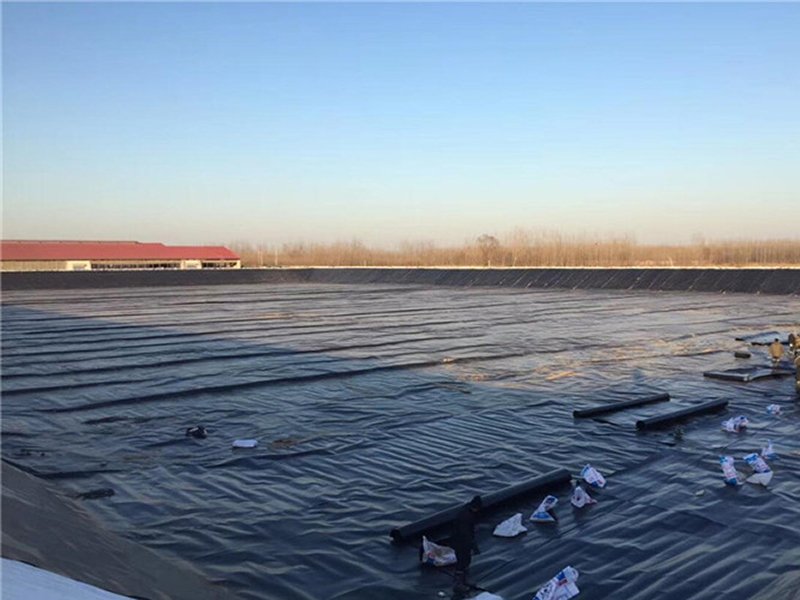
10. Case Study: BPM Geosynthetics Underwater Geomembrane Repair
In 2024, BPM Geosynthetics supplied 15,000 m² of 1.5 mm HDPE patches for a Canadian reservoir repair. Using extrusion welding and Aquamend adhesives, the project reduced leakage from 600 gallons/day to 12 gallons/day, achieving 98% watertightness. Completed in 4 days with diver assistance, it saved 90% compared to draining costs. Incorporating 50% recycled HDPE and geotextile underlay extended liner life by 15%.
11. FAQs
Can all geomembranes be repaired underwater?
Yes, HDPE, PVC, and EPDM liners are repairable with welding, adhesives, or patches.
How durable are underwater repairs?
Patches last 10–15 years; SIBELONMAT® systems last 20+ years, per IntechOpen .
Is draining required for large leaks?
No, diver-assisted patching or SIBELONMAT® handles large tears, per IntechOpen .
Are underwater adhesives safe for aquatic ecosystems?
Non-toxic sealants like Aquamend are fish- and plant-safe.
12. Conclusion
Underwater geomembrane repair is an efficient, eco-friendly solution for maintaining critical water containment systems, saving 80–90% compared to draining. Using techniques like patching, welding, and SIBELONMAT®, repairs achieve 95% watertightness, extending liner life by 10–20 years. By following this guide’s detailed steps—locating leaks, preparing surfaces, and applying repairs—operators can ensure leak-free performance. BPM Geosynthetics, with 15 years of expertise, offers customized solutions. Contact us to secure durable, sustainable geomembrane repairs.

